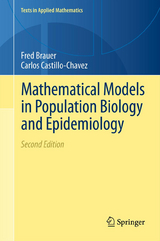Mathematical Models in Population Biology and Epidemiology
Seiten
2011
|
2nd ed. 2012
Springer-Verlag New York Inc.
978-1-4614-1685-2 (ISBN)
Springer-Verlag New York Inc.
978-1-4614-1685-2 (ISBN)
This textbook provides an introduction to the field of mathematical biology through the integration of classical applications in ecology with more recent applications to epidemiology, particularly in the context of spread of infectious diseases. It integrates modeling, mathematics, and applications in a semi-rigorous way, stating theoretical results and giving references but not necessarily giving detailed proofs, providing a solid introduction to the field to undergraduates (junior and senior level), graduate students in applied mathematics, ecology, epidemiology or evolutionary biology, sustainability scientists, and to researchers who must routinely read the practical and theoretical results that come from modeling in ecology and epidemiology.
This new edition has been updated throughout. In particular the chapters on epidemiology have been updated and extended considerably, and there is a new chapter on spatially structured populations that incorporates dispersal.The number of problems has been increased and the number of projects has more than doubled, in particular those stressing connections to data. In addition some examples, exercises, and projects include use of Maple and Matlab.
Review of first edition:
"A strength of the book is the large number of biologically-motivated problem sets. These and the references to the original biological papers would be valuable resources for an instructor." (UK Nonlinear News, 2001)
This new edition has been updated throughout. In particular the chapters on epidemiology have been updated and extended considerably, and there is a new chapter on spatially structured populations that incorporates dispersal.The number of problems has been increased and the number of projects has more than doubled, in particular those stressing connections to data. In addition some examples, exercises, and projects include use of Maple and Matlab.
Review of first edition:
"A strength of the book is the large number of biologically-motivated problem sets. These and the references to the original biological papers would be valuable resources for an instructor." (UK Nonlinear News, 2001)
Fred Brauer, Department of Mathematics, University of British Columbia, Canada; Carlos Castillo-Chavez, Mathematical, Computational and Modeling Sciences Center, Arizona State University, USA
Part I: Simple Single-Species Models. 1. Continuous population models. 2. Discrete population models. 3. Continuous single-species population models with delay.- Part II: Models for Interacting Species. 4. Introduction and mathematical preliminaries. 5. Continuous models for two interacting populations. 6. Harvesting in two-species population models. 7. Multi-species population models.- Part III: Structured Population Models. 8. Models for population with age structure. 9. Models for populations with spatial distribution.
| Reihe/Serie | Texts in Applied Mathematics ; 40 | Texts in Applied Mathematics ; 40 |
|---|---|
| Zusatzinfo | XXIV, 508 p. |
| Verlagsort | New York, NY |
| Sprache | englisch |
| Maße | 155 x 235 mm |
| Themenwelt | Informatik ► Weitere Themen ► Bioinformatik |
| Mathematik / Informatik ► Mathematik ► Angewandte Mathematik | |
| Naturwissenschaften ► Biologie ► Botanik | |
| Naturwissenschaften ► Biologie ► Ökologie / Naturschutz | |
| Naturwissenschaften ► Biologie ► Zoologie | |
| ISBN-10 | 1-4614-1685-X / 146141685X |
| ISBN-13 | 978-1-4614-1685-2 / 9781461416852 |
| Zustand | Neuware |
| Informationen gemäß Produktsicherheitsverordnung (GPSR) | |
| Haben Sie eine Frage zum Produkt? |
Mehr entdecken
aus dem Bereich
aus dem Bereich
Internationale statistische Klassifikation der Krankheiten und …
Buch | Softcover (2024)
Deutscher Ärzteverlag
24,98 €
Operationen- und Prozedurenschlüssel; Internationale Klassifikation …
Buch | Softcover (2024)
Deutscher Ärzteverlag
24,98 €
Allgemeine und spezielle Kodierrichtlinien für die Verschlüsselung …
Buch | Softcover (2024)
Deutscher Ärzteverlag
9,99 €




